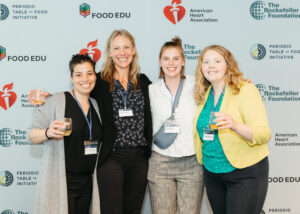
Colorado State University played a critical role in the recent launch of a new global project known as the Periodic Table of Food Initiative, or PTFI, a collaborative effort aimed at better understanding the biomolecular makeup and nutrition information for hundreds of types of food.
“The mission was to create an open and accessible set of tools that will allow us to characterize food composition in a way that’s more detailed, standardized and comparable,” said CSU’s Jessica Prenni, professor in the Department of Horticulture and Landscape Architecture in the College of Agricultural Sciences, who helped launch the new initiative.
Currently, many foods consumed around the world are not included in food composition databases, and the databases that do exist provide limited scientific information. The goal of the PTFI is to map the full biomolecular composition of the planet’s edible biodiversity and make the information — and the tools used in the process — publicly available.
A three-year effort to build an initial database resulted in a launch this week that includes detailed information on 500 foods. “Believe it or not,” Prenni said, “nothing like this existed.”

The initiative is the first scientific endeavor of its kind to provide global access to standardized tools — state-of-the-art mass-spectrometry and computing technologies — used to profile food quality. The Prenni Lab at Colorado State University along with the ARC-BIO core facility were key partners in the development of the technology and standardization for this effort. The more detailed information, Prenni said, could have implications for future research and advancements in fields such as nutrition, medicine and agriculture. For example, the PTFI database could be used to better understand how agriculture practices impact food composition.
“This is a first-of-its-kind effort to map food quality that could lead to groundbreaking discoveries that help us better understand how food impacts health,” said Nancy Brown, chief executive officer of the American Heart Association, a partner in the project. “With this knowledge, we’ll be able to promote affordable, sustainable and culturally relevant diets that help to improve health, address chronic disease and manage the food system’s impact on our planet.”
The initiative is co-managed by the American Heart Association and the Alliance of Bioversity and CIAT, a global agricultural research center, on behalf of The Rockefeller Foundation. The comprehensive food database will be made available in two open-access interfaces for scientific researchers worldwide: the initiative’s MarkerLab and the American Heart Association’s Precision Medicine Platform.
“The power of the Periodic Table of Food Initiative is in collaboration,” said Selena Ahmed, global director of the Periodic Table of Food Initiative at the American Heart Association and associate professor of sustainable food systems at Montana State University. “In an increasingly globalized food system, societal challenges must be addressed through international multilateral and transdisciplinary efforts. These efforts must go beyond the generation of data to its translation into guidelines and other solutions by collaborators to improve the health of people and the planet.”